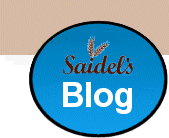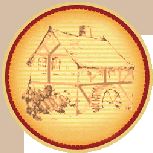by Les Saidel - September, 2014
(From an article to the Jerusalem Post, 18 Sep 20124. Reprinted with permission)
With the exception of farmers perhaps, few professionals closely adhere to the cycle of the Jewish year as do bakers.
A Jewish baker's year is concentrically cyclic in nature. It begins with the smaller, weekly cycle of Shabbat, followed by the larger cycles of the various festivals - the minor ones - Tu Bishvat, Purim, Channukah, and the major ones - Pesach, Shavuot and Sukkot. Encircling the above is the yearly cycle, beginning and ending with Rosh Hashana.
While the cyclicity of the Jewish year is obviously spiritual in nature, it is a baker's task to embellish the various highlights in the year's cycles with traditional fare. What would Purim be without a hamantasch, Channukah without a doughnut, or Rosh Hashana without a round raisin challah?
In fact challahs are braided in a circular shape on Rosh Hashana for exactly this reason, to symbolize the cyclic nature of the year and the circle of life.
Raisins are a completely different story.
According to tradition, Ashkenazi communities add raisins to their Rosh Hashana challahs, based on the tale of King David and Avigail.
As related in the book of Samuel, Avigail was married to a man named Naval, a crass individual lacking in tact. So much so that he incurred the wrath of David, who resolved to kill him. Avigail, in an attempt to save her household from destruction, launched into a persuasive monologue aimed at convincing David that his sentence of death was not justified. She embellished her plea with a gift of two hundred loaves of bread and one hundred clusters of raisins.
David, highly impressed by her wisdom, relented and spared Naval's life. Ten days later Naval died from natural causes. The story has a "Hollywood" ending with David finally marrying Avigail.
It's a nice story, with a happy end for the hero and heroine, but what does it have to do with Rosh Hashana?
According to commentators, the ten days in the story refer to the Ten Days of Repentance between Rosh Hashana and Yom Kippur. Avigail therefore presented her gift of bread and raisins to David on Rosh Hashana!
What was the clincher that ultimately persuaded David? Was it Avigail's spiritual wisdom? (according to the Talmud she is regarded as one of the 7 prophetesses). Was it the generous gift?
Being a baker myself, it would be nice to think that it was the bread that did it and that Avigail was such an accomplished baker she managed to win the heart of a king. That would fit nicely, but in this case honesty requires me to admit that it was not specifically bread related.
I would like to propose a theory that it was the raisins!
Which brings us to a central theme of Rosh Hashana ….. Everyone is familiar with tradition of dipping apple in honey, dipping challah in honey etc. The symbolic reason is clearly stated - so it should be a sweet year!
The year, (and life) are cyclic in nature. There are highlights, plateaus, depressions. Throughout the year we have bread, it is the staple of our daily grind. Bread is an essential, it gets us through the day, but alone it is not enough.
Sometimes it needs to be punctuated with raisins. When we are experiencing a particularly dark period, a depression in the cycle, when all hope seems lost, we need to inject a little sweetness to lift us up and get us through. Avigail, in her wisdom, realized this fact and in addition to the two hundred loaves of bread, added raisins to her gift.
The higher spheres of intellect and spirituality are not always sufficient in themselves. Sometimes they need something as mundane as a loaf of bread with a few raisins to truly open our hearts and lift us up. To me that is the true lesson of this story and a central message of the Rosh Hashana challah.
I would like to take this opportunity of wishing one and all a sweet New Year and remember, no matter how bleak things may seem …. there will always be raisins.
Les Saidel
© Copyright. All rights in the above articles are reserved to the author Les Saidel.
No part of this website or the above articles may be transmitted in any form or by any
means without permission in writing from the author.




